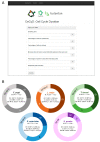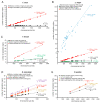Comparative Analysis of the Minimum Number of Replication Origins in Trypanosomatids and Yeasts
- PMID: 32397111
- PMCID: PMC7288466
- DOI: 10.3390/genes11050523
Comparative Analysis of the Minimum Number of Replication Origins in Trypanosomatids and Yeasts
Abstract
Single-celled eukaryote genomes predominantly replicate through multiple origins. Although origin usage during the S-phase has been elucidated in some of these organisms, few studies have comparatively approached this dynamic. Here, we developed a user-friendly website able to calculate the length of the cell cycle phases for any organism. Next, using a formula developed by our group, we showed a comparative analysis among the minimum number of replication origins (MO) required to duplicate an entire chromosome within the S-phase duration in trypanosomatids (Trypanosoma cruzi, Leishmania major, and Trypanosoma brucei) and yeasts (Saccharomyces cerevisiae and Schizosaccharomyces pombe). Using the data obtained by our analysis, it was possible to predict the MO required in a situation of replication stress. Also, our findings allow establishing a threshold for the number of origins, which serves as a parameter for genome approaches that map origins. Moreover, our data suggest that when compared to yeasts, trypanosomatids use much more origins than the minimum needed. This is the first time a comparative analysis of the minimum number of origins has been successfully applied. These data may provide new insight into the understanding of the replication mechanism and a new methodological framework for studying single-celled eukaryote genomes.
Keywords: DNA replication; S-phase duration; cell cycle phases; replication origins; trypanosomatids; trypanosomatids genome; yeasts.
Conflict of interest statement
The authors declare no conflict of interest.
Figures



References
-
- Stanojcic S., Sollelis L., Kuk N., Crobu L., Balard Y., Schwob E., Bastien P., Pagès M., Sterkers Y. Single-molecule analysis of DNA replication reveals novel features in the divergent eukaryotes Leishmania and Trypanosoma brucei versus mammalian cells. Sci. Rep. 2016;6:23142. doi: 10.1038/srep23142. - DOI - PMC - PubMed
Publication types
MeSH terms
Substances
LinkOut - more resources
Full Text Sources
Molecular Biology Databases

